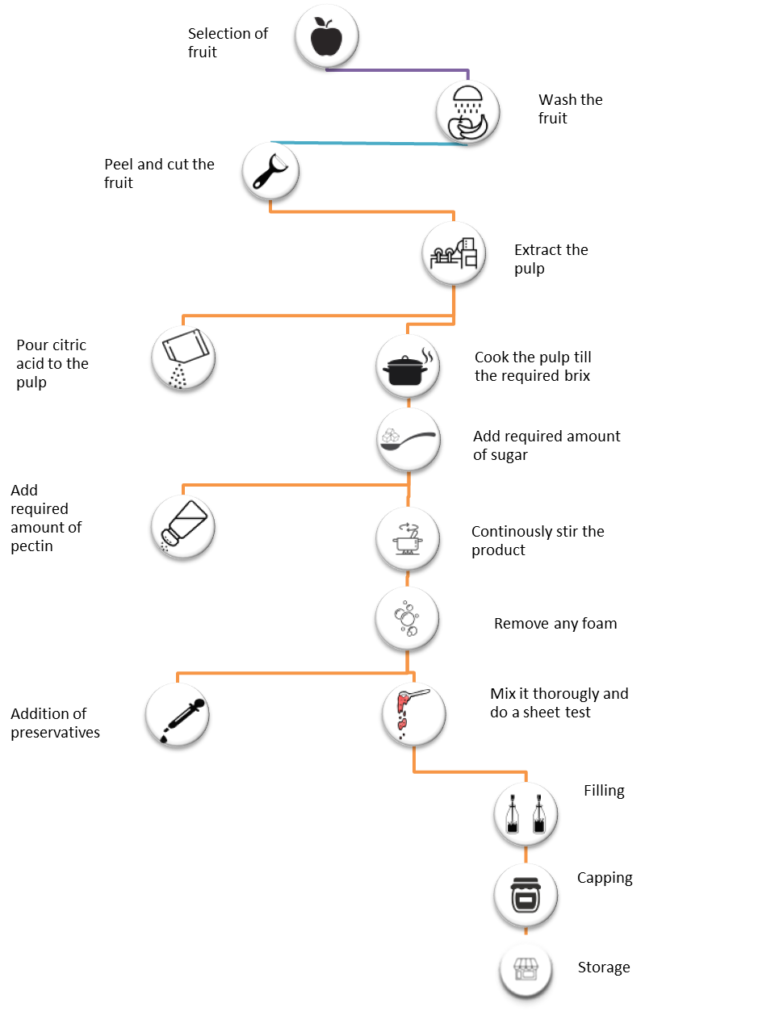Fruit & Vegetable Consultancy
Our team of food technologists focuses on our client’s perspective and walk together in shaping up their food product ideas, food product formulation, stability studies, food testing, nutritional testing, quality, and shelf-life testing.
FRUIT AND VEGETABLE
This section focuses on the processing of fruit & vegetable products. The technology involved varies for each type of product due to physical and chemical composition of the end product
Nutritional composition
Vegetables and fruits have similar nutritive properties. 70 percent or more of their weight is water, they provide comparatively little energy or protein, but many contain vitamin C and carotene. The dark-green leafy vegetables are particularly good sources of vitamin A activity. The more typical fruits, such as apples, oranges, and berries, are rich in sugar. Bananas are a good source of potassium. Vegetables and fruits also contain fibre.
Reference Flow Chart For Jam Processing
Quality concern
Processed fruit and vegetable product quality is determined by the quality of the raw materials utilized.The efficiency and care taken during handling, processing, storage and distribution. Fresh fruits and vegetable are susceptible to fungal growth due to their ph & water content.
Type of products
- Thermally processed fruits/ vegetables
- Canned & Ready to eat
- Processed pulp
- Pulp/puree and concentrate:
- Squashes
- Cocktails
- Soup powders/fruit based beverage mix/powdered fruit based beverage
- Fruit bar
- Candied, crystallised and glazed fruit / vegetable / rhizome / fruit peel
- Tomato ketchup and tomato sauce/soyabean sauce/vinegar/ chutney
- Jams, fruit jellies and marmalades/fruit cheese
- Dehydrated vegetables/dehydrated fruits/grated desiccated coconut:
- Frozen fruits/fruit product/frozen vegetables
- Pickles
- Coconut milk/coconut cream/. Coconut milk powder
- Vegetable protein products Edible fungi products/dried fungi/pickled fungi/fermented fungi/quick frozen fungi

FAQ's
Food fortification or enrichment is the process of adding micronutrients (essential trace elements and vitamins) to food. .Food fortification is a proven, sustainable, cost-effective and high-impact solution to address micronutrient deficiencies.
Food fortification can also be categorized according to the stage of addition:
1. Commercial and industrial fortification (Finished products)
2. Bio fortification (breeding crops to increase their nutritional value, which can include both conventional selective breeding, and genetic engineering)
3. Home fortification (example: vitamin D drops)
Fortification compounds used
• Vitamin A
• Vitamin D
Preservatives are added to food to fight spoilage caused by bacteria, molds, fungus, and yeast. Preservatives can keep food fresher for longer periods of time, extending its shelf life. Food preservatives also are used to slow or prevent changes in color, flavor or texture and delay rancidity.
When it comes to preserving foods, there are two methods: physical and chemical. Drying, refrigerating and freezing are examples of physical preservation. Chemical preservation involves adding ingredients called additives to food in order to prevent oxidation, rancidity, bacterial growth, etc. There are both natural and synthetic preservatives that are used in food
Common preservatives used
• Nisin
• Sorbic acid
• Propionic acid
Antioxidants are used as food additives to help guard against food deterioration. Exposure to oxygen and sunlight are the two main factors in the oxidation of food. Antioxidants are an especially important class of preservatives as, unlike bacterial or fungal spoilage, oxidation reactions still occur relatively rapidly in frozen or refrigerated food.
These preservatives include natural & synthetic antioxidants
Common antioxidants used
• L- Ascorbic acid (Natural)
• Ascorbyl palimtate ( Synthetic)
• Tocopherols (Natural)
• Propyl gallate (Synthetic)
• Butylated hydroxy anisole ( Synthetic)
Acidity regulators, or pH control agents, are food additives used to change or maintain pH (acidity or basicity).Theycan be organic or mineral acids, bases, neutralizing agents, or buffering agents.
Some acidifiers also act as stabilizers; others help antioxidants or emulsifiers, or assist in colour retention. It may seem a minor parameter, but to maintain the appropriate pH is the first step to ensure food safety and a longer shelf life.
Commonly used acidity regulators
• Calcium and magnesium carbonates
• Sodium bicarbonate and Sodium carbonate
• Sodium and Calcium hydroxide
• Sodium phosphate
The colour of your food plays an important role by visually stimulating your appetite. But have you ever wondered where these colours come from?
Food colourings are of two types: artificial and natural. Not surprisingly, natural colours are a better alternative as they are wholly derived from plants. Natural colouring usually appears less vibrant when compared to artificial colouring. This however, does not affect the taste of your food.
Commonly used food colours
• Natural -Chlorophyll
• Natural -Caramel
• Natural -Curcumin or turmeric
• Natural – Beta carotene
• Natural -Riboflavin, Lactoflavin
• Natural -Annato
• Natural -Saffron
• Natural -Canthaxanthin
• Synthetic- Ponceau 4R
• Synthetic- Carmoisine
• Synthetic- Erythrosine
• Synthetic- Tartrazine
• Synthetic- Sunset Yellow FCF
• Synthetic- Indigo carmine
• Synthetic- Brilliant blue FCF
• Synthetic- Fast green FCF
Acidity regulators, or pH control agents, are food additives used to change or maintain pH (acidity or basicity).Theycan be organic or mineral acids, bases, neutralizing agents, or buffering agents.
Acidity regulators, or pH control agents, are food additives used to change or maintain pH (acidity or basicity).Theycan be organic or mineral acids, bases, neutralizing agents, or buffering agents.
Commonly used acidity regulators
• Calcium and magnesium carbonates
• Sodium bicarbonate and Sodium carbonate
• Sodium and Calcium hydroxide
• Sodium phosphate
